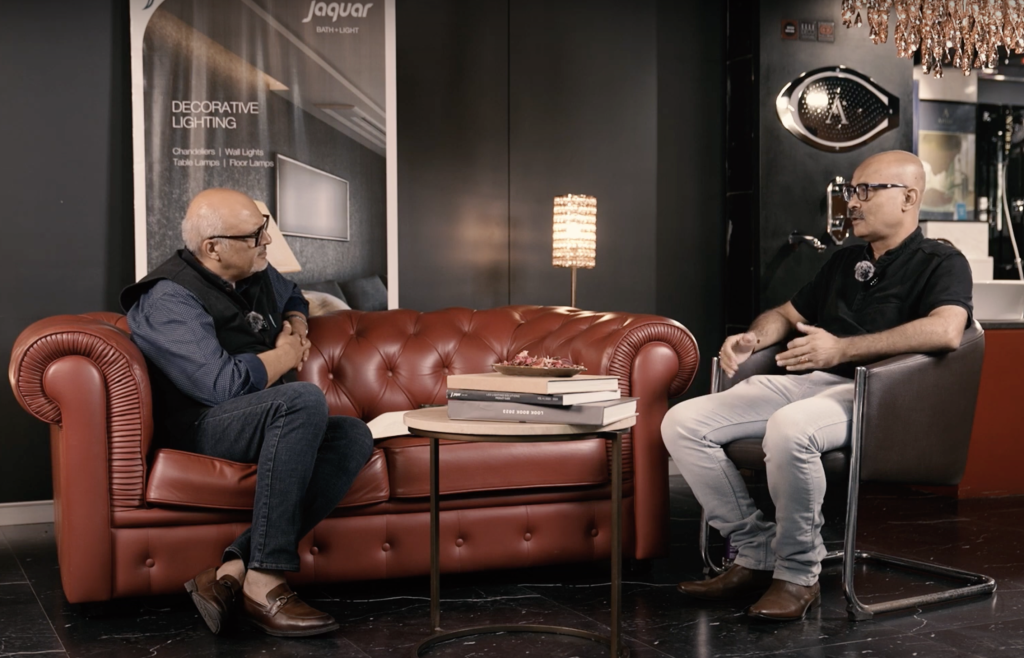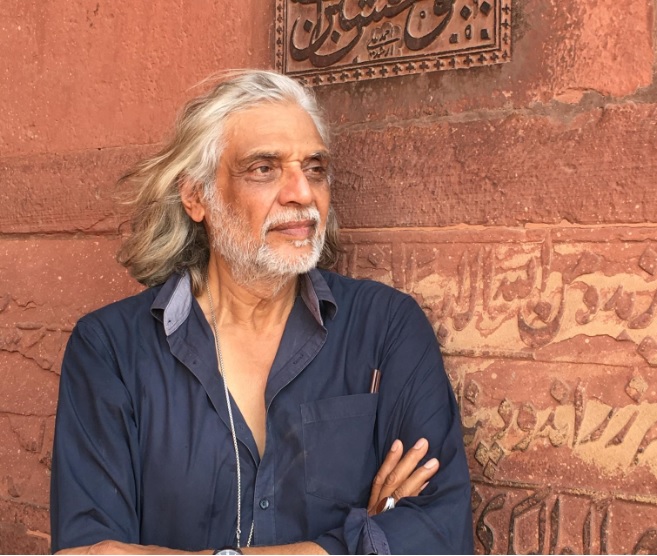Welcome to Samvaad, where art meets conversation, and inspiration knows no bounds. Here we engage in insightful conversations with eminent personalities from the art fraternity. Through Samvaad, Abir Pothi aims to create a platform for thought-provoking discussions, providing readers with an exclusive glimpse into the creative processes, inspirations, and experiences of these creative individuals. From curating groundbreaking exhibitions to pushing the boundaries of artistic expression, our interviews shed light on the diverse perspectives and contributions of these art luminaries. Samvaad is your ticket to connecting with the visionaries who breathe life into the art world, offering unique insights and behind-the-scenes glimpses into their fascinating journeys.
People like Mr. Pinaki Bhattacharjee serve as guiding lights in the dynamic field of architecture, where creativity and functionality, tradition and contemporary, meet. Mr. Bhattacharjee has over twenty years of experience influencing Guwahati’s architectural scene. He is a source of knowledge on the complex interplay among urban growth, cultural legacy, and environmental sustainability. Mr. Nidheesh Tyagi from Abir Pothi will be joining us in this insightful debate. His deep interest in the nexus between art and architecture brings a special viewpoint to our discourse. We explore Mr. Bhattacharya’s insights, viewpoints, and insightful observations on the history, current state, and future of architecture in the area together. Mr. Bhattacharjee’s words offer priceless lessons for aspiring architects, artists, and fans alike, covering everything from the union of history and innovation to the challenges of urbanisation and the requirement of ecological balance. Come along with us as we take a tour of Guwahati’s architectural landscape led by one of its most renowned practitioners, Mr Pinaki Bhattacharjee.
Nidheesh: Is it okay to talk about Guwahati’s relationship with the Brahmaputra? Because this is the other thing which is not just happening here but in most cities now, the river and the city, the relationship between them is also changing based on the number of people kind of dependent on that and the industry and all that is also happening around it, right? Through the Ganges in all of Uttar Pradesh and probably here. What is the relationship between Guwahati and Brahmaputra? Can you talk about that?
PB: Actually, the city of Guwahati has developed because of the river Brahmaputra. It was, earlier, the waterways which used to connect us. Even when we were invaded by the British, it was through this waterway Guwahati was captured. They came through the waterways and landed in a place called Sukreswar. That’s the gate wherein they entered for the first time. So, it’s a great connection. Our terrains are so difficult; that they could hardly climb off the hills to come into this area. So, water was a good connectivity. Now, again, the inland water services, there is an improvement, and there is a thrust to develop this as a trade route also, plus a tourism route also. Apart from that, we largely depend on the city of Guwahati unless I think there is a lot of water which is pumped from underground to serve the needs of the city. But this can be curtailed or even minimised to an extent that we hardly would require any underground water if the potential of the river is tapped. Because of the length of it, it’s a longish type of city, and the entire spread is along the river. Yeah, it’s now spreading on the other side of the river also. So, if in case we can tap proper water points from the Brahmaputra, I think we will be able to feed the entire city properly.
Nidheesh: The other thing is also about the great environment and ecosystem of the Northeast. Do you think that this has been factored into the master plans and the constructions happening, and the way they are? I mean, we saw a huge kind of deluge happening in Himachal recently, big-time constructions, and then suddenly it’s all failing, faltering. So, how do you think about managing this whole ecological environmental balance?
PB: That’s a very dicey question, actually. I’ll tell you, nature will accept changes as we make it to a certain point. After that, it’s going to fight back, and it’s going to fight back in such a way that we’ll have to pay a very high price for it. So, that is what has happened in Uttarakhand or in Himachal Pradesh. This region is no different. In the idea of developing places, we start destroying nature way beyond repair. In Meghalaya, it’ll be amazing to see hills and the hillocks are completely chopped off to bring it to a single level. Will there not be an implication of it in the long run? There has to be some effect. Even in Shillong, if in case you go, to the buildings which were there about 20-25 years back, you won’t find even a ceiling fan in it. The ceiling heights are low. But nowadays, we need air conditioning in Shillong. So, such is the change of environment. We are trying to accommodate more than it can hold. The nature can hold. There are multiple problems. We can spread the city horizontally, but yes, horizontal spreading the city needs a lot of funds because to create horizontal growth, we have to create roads, drainage, and lots of infrastructure has to be created. And therefore, we intend to go further ahead, we do it within the same place, and we burden the same place more than it can take. That is also happening here in this part of the country. So, there’ll be some negative fallout from it, of course. This year, the last year, we had temperatures climbing to almost 38, 39, and 40°C, which we never faced in India earlier. It used to be like if in case we have a hot day or two, two consecutive or three consecutive hot days means for sure it is going to rain on the third day. But nowadays, we have stretched, and herein, we were used to seeing rainfall continuing for days together, nonstop, just that the intensity will drop and again will pick up. Such was the condition for days together, for weeks together we used to see. Nowadays, it doesn’t even go for half an hour in one stretch. So, we have seen the fallout of urbanization or ruthless development, should we say.
Nidheesh: How do you see the future of cities like these? You know, these are like signature important cities in the region. But then, how do you think that, you have already been working for the last 25 years here and you’ve been here for like 12 generations as you were telling me. So, the next 25-30 years, the span.
PB: I see a change in the type of development. See, change will be there. We have now been signatories to reducing the carbon footprint as a nation, so there will be some stringent moves in buildings, absolutely. And there are buildings which are being developed which are more eco-friendly buildings because we need buildings. It’s not that we don’t require it; we are building because there is a need for it. But how can we make it more sustainable? So, there will be a change in the programs. Nowadays, what we used to do, we used to have from the discharge from our toilets, we used to have something called a septic tank, and then it would run into the main river. But nowadays, it has become mandatory that you check your discharge through STP and maintain a level, I mean the pollution level is controlled, so that the discharge is acceptable. So, such is happening that we have to reuse water; we have to see that the energy, there is a part of the energy in such bigger projects, it’s a part of the energy we generate ourselves through solar means so the energy consumption gets reduced. These are the initial stages. We will see many more changes, dynamic and scientific changes coming up, which will be accepted by the new generations, and they’ll be more apt with it.
Nidheesh: One of the things which we want to talk about because Abir Pothi is an art newspaper and we kind of keep talking to architects about where are the meeting points between art and architecture and aesthetics and design. Where does art feature in your scheme of things as a practising architect?
PB: Interestingly, art features in every project of mine at the beginning, and then as we start this discussion between the clients, it keeps growing. We tend to dissuade art into more of a functional aspect and try to sideline the art part of it to a great extent and cover it mostly with architecture. That is what we see in today’s architecture form mostly. But yes, not just me, I think every architect, visualise the building or he or she would visualise a building as a form of art which will be very dear to that person. But yeah, somewhere there’s a compromise that we make because of many requirements, and finally, you know, as much as it is possible to preserve, we preserve. The rest of it is lost.
Nidheesh: And what about the art in public spaces? Like, you know, how much do you see because as we say the whole character of a region or a city is also about the motives it has, you know, iconic kind of places it has. So, how do you see that happening in Guwahati and surrounding areas?
PB: So, Guwahati, as such, is seen as a city which is not just a gateway to the Northeast part of India but also as a gateway to the entire Southeast Asia. So, our development should focus on creating an environment plus cultural art motive which will have ample representation of entire Southeast Asian countries.
Nidheesh: What will be like, you know, if I, as such a senior practising architect, what will be your advice to your younger version? I mean, say, you know, who is just 24 and he just came out of college and trying to practice architecture or design. What will you tell him?
PB: I think there’s one thing I would like to stress upon: immediately after passing out, one should practice under a senior architect for some time because that is also where you learn architecture in the practical form. Then you can set up your own practice. They are extremely intelligent and extremely adaptive; they will be able to give a much better world to the future requirements of this country.
Nidheesh: And what do we tell to young artists who are basically because we also have this whole thing about Hinterland artists coming from small towns, lots of people from the Northeast kind of come and participate in our shows, and we showcase them on our art gallery, we talk about them. So, what do they do to get some kind of a connection or some kind of engagement with architects and real estate or the industry for acceptance?
PB: I think the scope is increasing with affordability. See, this is one aspect which will be covered only when you are able to cover the rest of the remaining mandatory requirements. But nowadays, people look beyond mandatory requirements, and therefore, these are reflections even in an apartment building or a society. These are reflections of the society and the culture, I mean, what is called aspirations of the entire society. So, they create space, they provide that space wherein such things can be on display.
Nidheesh: Thank you so much, Mr. Bhatacharya, for coming for this show, you know we’ll keep talking to you, and then maybe we’ll get you to write for Abir one day as yours, you know, as we were discussing. Thank you so much for joining us for this special edition of Abir Pothi Samvaad.
PB: Thank you so much. Thank you for this opportunity.






